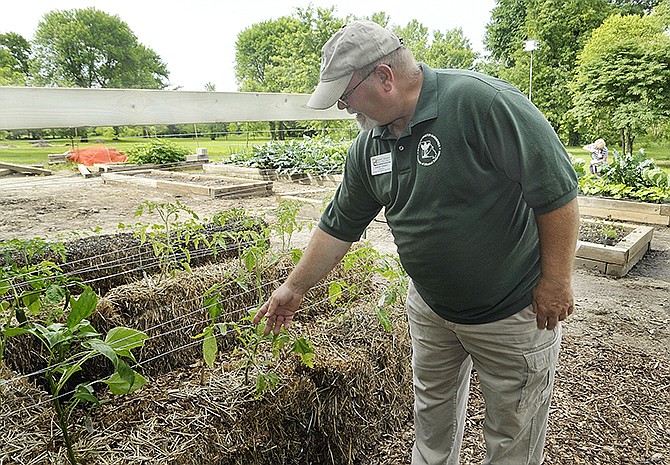Limited space and soil are no longer obstacles to keep you from gardening. All you need to grow beautiful plants and tasty vegetables is a bale of straw.
"Straw bale gardening is something that a lot of people embraced as a simple and compact system to grow their own plants," said Patricia Barrett, regional ag business specialist at the University of Missouri Extension in Miller County.
Though essentially a form of container gardening, with straw bale gardening, the container is the bale itself.
At a price of roughly $4 a bale, straw bale gardening is not only cost efficient, but can work in any house, deck or garden. And with no digging or weeding necessary, it is any easy technique for gardeners or all ages and skill levels.
Get started
To start a straw bale garden, all you need is a simple bale of straw, water, some fertilizer and a little bit of patience.
To prepare the bale for planting, you must condition it for about a month. The process is easier than it sounds, according to Barrett. The first day, you pour water on the bale until the water goes to the bottom. The next day, you pour in two cups of dry fertilizer.
"Generally you can use a normal vegetable fertilizer that has a formulation with the same quantity of the NPK components, which are nitrogen, phosphorus and potassium," Barrett suggested. "After placing the dry fertilizer on top of the bale, the bale must be watered thoroughly until water runs out the bottom of the bale. Each time you add dry fertilizer, it must be watered into the bale."
On the third day, you pour in one cup of water, followed by one cup of fertilizer on the fourth day. You continue this routine until you have used six cups of fertilizer and watered the bale for 10 days.
At this point, the bale is heating and composting, but there is too much heat for new plants to take root. After about 30 days, the conditioning process will be completed and the bale will be at the right temperature for planting.
"You can use a meat thermometer to check that the temperature reached about 70 degrees, ambient air, or simply feel it with your hand," Barrett said.
When the bale is ready
"Some people put the plant directly on the straw, and this is fine, but the method I teach is to make a layer of actual soil on the top of the bale or dig a hole in it," Barrett said.
You can grow almost anything in a bale of straw: flowers, tomatoes, sweet pepper, sweet potatoes, onions, carrots and so on. Barrett usually plants sweet potatoes for her demonstrations, because at the end of the season, it is easy to break the straw bale open and harvest the potatoes. Sweet potatoes also create an aesthetically pleasing display of vines as they grow, she said.
The only upkeep the bale requires is water every couple of days, otherwise it will dry up quickly, especially if the climate is dry.
Plants will receive less nutrition from the bale than they would from soil, so it's important to fertilize them every week or two.
Barrett pointed out plants like tomatoes require a little more care. In fact, they need a lot of nutrients and extra lime. She recommends incorporating some gypsum and watering the bale more often.
Some tips
While straw bale gardening is easily accessible for all sorts of garden enthusiasts, growandmake.com offers some tips for making the most of the experience.
Make sure you use real straw rather than hay. Straw bales can be made from wheat, oat or alfalfa. Since it is harvested after the grain and chaff have been removed, it doesn't include a lot of seed material. Hay, on the other hand, has lots of seeds inside, which will sprout and could invade your vegetables crops. Avoid pine straw, as the waterproof pine needles shed water too much for this application.
Choose a sunny spot to place the bale and make sure it's where you want it to stay. Once the bale gets wet, it will become much heavier and harder to move.
You can grow just about anything in a bale, even though some kinds of indeterminate plants - plants that bear fruit over the course of a season - grow too tall and heavy and break the bale apart. If you want to grow tomatoes, for instance, make sure you choose a bush type or other determinate varieties, which will bear their crop all at once, and provide the bale with a trellis.
Many people like the rustic look of the straw bale, but if you're not among them there is nothing wrong with partially concealing the bale or covering it with another material. This won't damage the bale, but natural materials such as wood are preferred.

